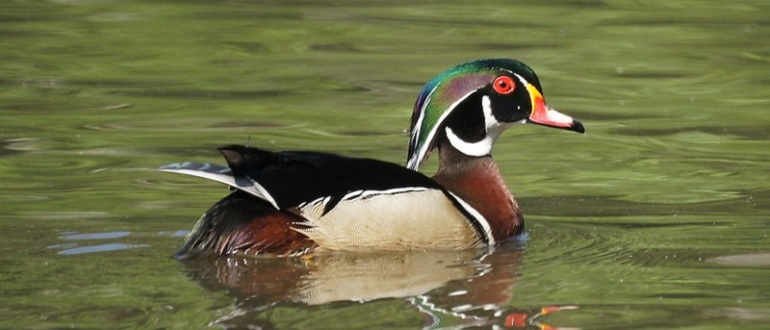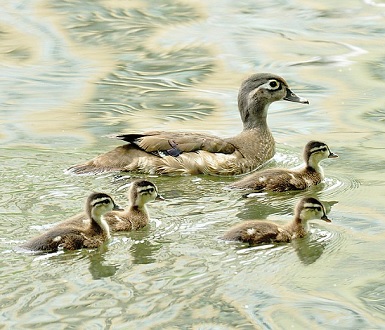A Fine Coat of Many Colors
GET TO KNOW
Wood Ducks
Admired by artists, photographers, and nature lovers, the North American wood duck is one of the most beautiful birds in the world.
Fun Fact – While wood ducks eat a variety of plant and insect matter, they consider acorns the best treat of all. Sometimes nicknamed “acorn ducks”, these ducks like woodlands full of oak trees. There, they vigorously root around the forest floor in search of their favorite acorn prize.
Each fall, the male wood duck dons his striking coat of many colors and goes a courtin’ to find his lady love. In fact, this duck’s scientific name Aix sponsa roughly translates to “betrothed waterbird” in reference to his dashing, winter “bridal” coat.
As is the case with most bird species that do not share parental duties, bright plumages are reserved only for males (drakes). While the fellows are show-offs, the females have soft colors in order to blend in while raising hatchlings. Nonetheless, female wood ducks are beautiful in their own right. They may be identified by a distinctive white ring around the eyes and a bright blue wing patch that becomes visible when the wings are spread in flight.
HABIT AND LIFE CYCLE
As their name implies, wood ducks inhabit wetland woods. They are specifically adapted to spend time both on the water and perched in trees. Their wing design allows for rapid and accurate flight between trees, and (unlike most ducks) they have strong claws that allow them to grip tree branches.
In Michigan, wood ducks are migratory visitors. They generally arrive in March and are already monogamously paired for the spring breeding season. In this area, we are fortunate to witness the drakes as they arrive in full and splendid color.
Hens build nests in tree cavities high above the ground (as high as 50 feet). They will also nest in human provided nesting boxes if properly installed. Eggs are laid once per day until a large clutch (as many as 18) of eggs fills the nest. During this extended laying period, wood duck hens often visit each other’s nests on the sly and leave an egg behind. Obligingly, each hen incubates all eggs residing in her nest. It is not clear why wood duck hens regularly gift each other with eggs, but it is generally believed to be an attempt to increase the species’ survival rate.
Unfortunately, baby wood ducks have an extremely high mortality rate. 80% to 90% perish from predators within the first few weeks of life. Nests may be raided by raccoons, owls, snakes, and others; and the entire clutch may fall prey. Hens with a completely failed nest may attempt a second, or even a third clutch of eggs if the male is still present and the weather allows.
Newly hatched wood ducks have feathers and are instinctively able to swim and find food. Consequently, they only stay in the nest for a single day before jumping out to follow mom to water. Amazingly, even though they cannot yet fly, the tiny hatchlings easily survive the long jump from nest to ground. The ducklings are then reared on the water, where they face many dangers from water currents and predators.
Male wood ducks do not share in incubation duties or in raising hatchlings. Once the female is settled into the incubation process, the male leaves. It is time for him to depart on another migration – one he generally takes with a large flock of fellow drakes. Together they fly, sometimes many hundreds of miles, to find isolated wetlands where they undergo a summer molt. During this molting process, the male sheds all of his bright and beautiful feathers and regrows a softer, brown coat (called the eclipse coat) that is very similar to that of the female. And while most birds shed primary flight feathers one at a time, many ducks (including the wood duck) shed all primary flight feathers at once. This leaves the bird flightless – and fairly helpless – for up to a month and a half while new flight feathers grow in.
Meanwhile, once the baby wood ducks take flight, the hens must also find a safe molting site. However, since much of the summer has now passed, females generally stay closer to nesting sites. And while hens also undergo a complete molt, their color pattern remains fairly unchanged.
After molting, wood ducks in northern areas of the continent return south for the winter. Sometime, during late fall or early winter, they molt a second time. Males regrow their fancy “bridal coats” and show off for the ladies. New mating pairs form, and the migration cycle begins again. Biologically, wood ducks are capable of living up to 15 years. Unfortunately, due to predation and hunting, few survive in the wild more than three to four years.
TAKE ACTION
Prized for both their beautiful feathers and their meat, wood ducks were once hunted to the brink of extinction. The combined threats of hunting and woodland habitat destruction almost erased these lovely birds from existence at the beginning of the 20th century. Fortunately, the migratory bird act of 1918 provided protection for waterfowl and banned all hunting of wood ducks. (Today hunting of wood ducks – on a very limited basis – is allowed in some states.) Additionally, nationwide efforts to protect wooded nesting sites have helped this species return to stable population levels.
Still wood ducks need our ongoing help to preserve their wetland homes and to keep hunting conservatively limited. Private citizens who own wooded wetlands can best help these ducks by preserving mature trees as nesting sites. Nesting boxes can also be provided. However, nesting boxes often provide inadvertent assistance to predators like raccoons and snakes. The proper installation of a nesting box also requires a serious commitment to proper maintenance of the box. See (wood duck boxes) for additional information.
Additionally, please do not feed our waterfowl friends. Ducks, geese, swans, and other beautiful waterbirds can get very sick from eating human food (especially bread and junk food). Additionally, artificial feeding of these birds disrupts their natural foraging behaviors and leads to artificially high concentrations of birds in small areas. Such concentrations of individuals also leads to excessive levels of animal waste/bacteria entering the waterway.
Our Rouge River watershed is home to a variety of beautiful ducks and other waterfowl. Help us protect their habitat homes today. You can stay up to date on FOTR happenings and events by following us on Facebook
Main photo credit: Male wood duck (Aix sponsa) in full color – photo by Mike’s Birds CC-BY-SA-2.0 – image cropped

